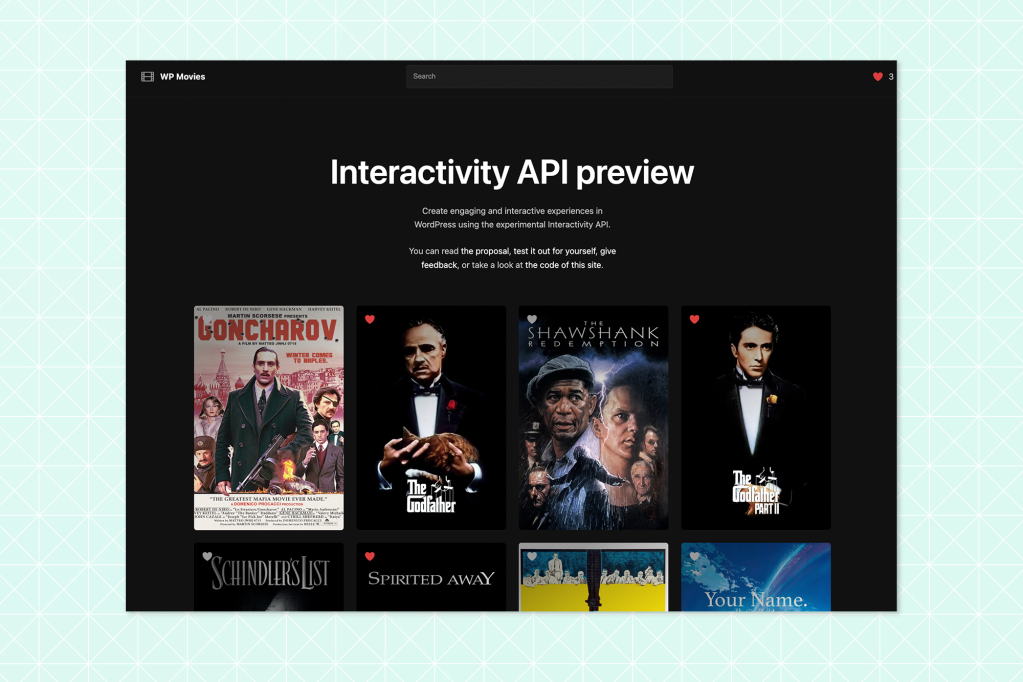Simply having a website that serves up information doesn’t cut it anymore. Today’s users crave more—they want to engage with content, experience personalization, and immerse themselves in interactivity during web visits. With its reputation for flexibility and user-friendly platform, WordPress provides a wealth of tools and plugins designed to elevate static websites into dynamic, interactive spaces.
From incorporating game mechanics and crafting interactive narratives to implementing dynamic user interfaces, WordPress is equipped to help you capture and hold your audience’s attention innovatively. The advent of the Interactivity API marks a significant leap forward, opening new doors to enhance user experiences like never before.

What is the WordPress Interactivity API?
With WordPress 6.5, the Interactivity API has emerged as a pivotal tool for developers aiming to create more engaging and dynamic websites. This groundbreaking API facilitates a range of interactive features directly within WordPress, from smooth client-side navigations and transitions without full page reloads to complex components such as calculators, voting systems, or live filtering. The API leverages directives like wp-on, wp-bind, wp-class, and more, enabling HTML elements to react to user interactions or data changes dynamically.
The Interactivity API is significant because it standardizes interactive web development practices within WordPress. By offering a common framework for adding interactivity, it resolves the inconsistencies and challenges previously faced by developers, allowing for a more unified and streamlined development process. This integration simplifies the creation of interactive elements and ensures compatibility and ease of maintenance across different WordPress projects.
Key Features of the WordPress Interactivity API
1. Dynamic Content Management
The Interactivity API allows real-time updates and content manipulation, providing a more responsive and engaging user experience. Whether updating a post, fetching new content, or managing user interactions, the API ensures that these actions are performed efficiently and seamlessly.
2. Enhanced Customization
Developers can harness the Interactivity API to create custom endpoints and extend the functionality of their WordPress sites. This level of customization is crucial for building tailored solutions that meet specific client needs or project requirements.
3. Improved Performance
The Interactivity API helps improve site performance by enabling asynchronous operations. Content can be loaded dynamically without requiring full page reloads, resulting in faster and more fluid user interactions.
4. Seamless Integration
The API’s compatibility with various front-end frameworks like React, Vue.js, and Angular makes it an ideal choice for modern web development. This flexibility allows developers to create sophisticated, interactive applications that integrate with WordPress fully.
Practical Applications
Real-Time Updates
For news sites, social networks, or any platform where real-time information is crucial, the Interactivity API can be used to push updates instantly. This ensures that users always have access to the latest content without the need to refresh their browsers.
Interactive Dashboards
Businesses can leverage the Interactivity API to create custom dashboards that provide real-time analytics, user interactions, and other dynamic content, enhancing the decision-making processes by providing timely and relevant data.
Gamification and Enhanced User Engagement
The Interactivity API allows interactive elements such as polls, quizzes, and live chats to be easily integrated. These features can significantly boost user engagement and interaction, making the website more appealing and user-friendly.
Real-World Examples
Here are some real-world examples of using the WordPress Interactivity API to enhance front-end interactivity:
Movie Demo Plugin
The wp-movies-demo plugin on GitHub showcases how to use the Interactivity API to build interactive blocks. This demo includes features like playing movie trailers and displaying actor information using custom blocks built with the API. The repository provides a complete setup guide, including installing necessary plugins, importing sample data, and activating the custom theme for a fully interactive movie database site.

Custom Form Submission Block
In a Developer Hours session hosted by WP Engine’s Damon Cook, a form submission block was created using the Interactivity API. The example demonstrated how to use directives to assign critical attributes to HTML markup, create a store, and link up client-side JavaScript to handle form submissions. Watch the session.
Interactive Games
Jonathan Bossenger has built a game called “Dodge” using the Interactivity API. This game leverages the API’s ability to manage real-time interactions and dynamic content updates, showcasing how gaming mechanics can be implemented in a WordPress environment. Learn more.
Transform Your Enterprise Website with the WordPress Interactivity API
The WordPress Interactivity API is a transformative tool for enterprise websites, offering enhanced user experiences, simplified development processes, and robust performance improvements. Its integration with the Gutenberg block editor, standardized approach to interactivity, and ability to handle diverse use cases make it an essential component for modern web development. By reducing development time and costs, this API allows enterprises to quickly adapt to changing market demands and deliver engaging, dynamic web experiences.
As you consider leveraging the power of the WordPress Interactivity API for your enterprise website, partnering with experts can make all the difference. Trew Knowledge, a leading WordPress agency, is ready to help you harness the full potential of this API. With a proven track record of delivering high-quality, innovative WordPress solutions, Trew Knowledge is equipped to enhance your website with cutting-edge interactivity and seamless performance.


